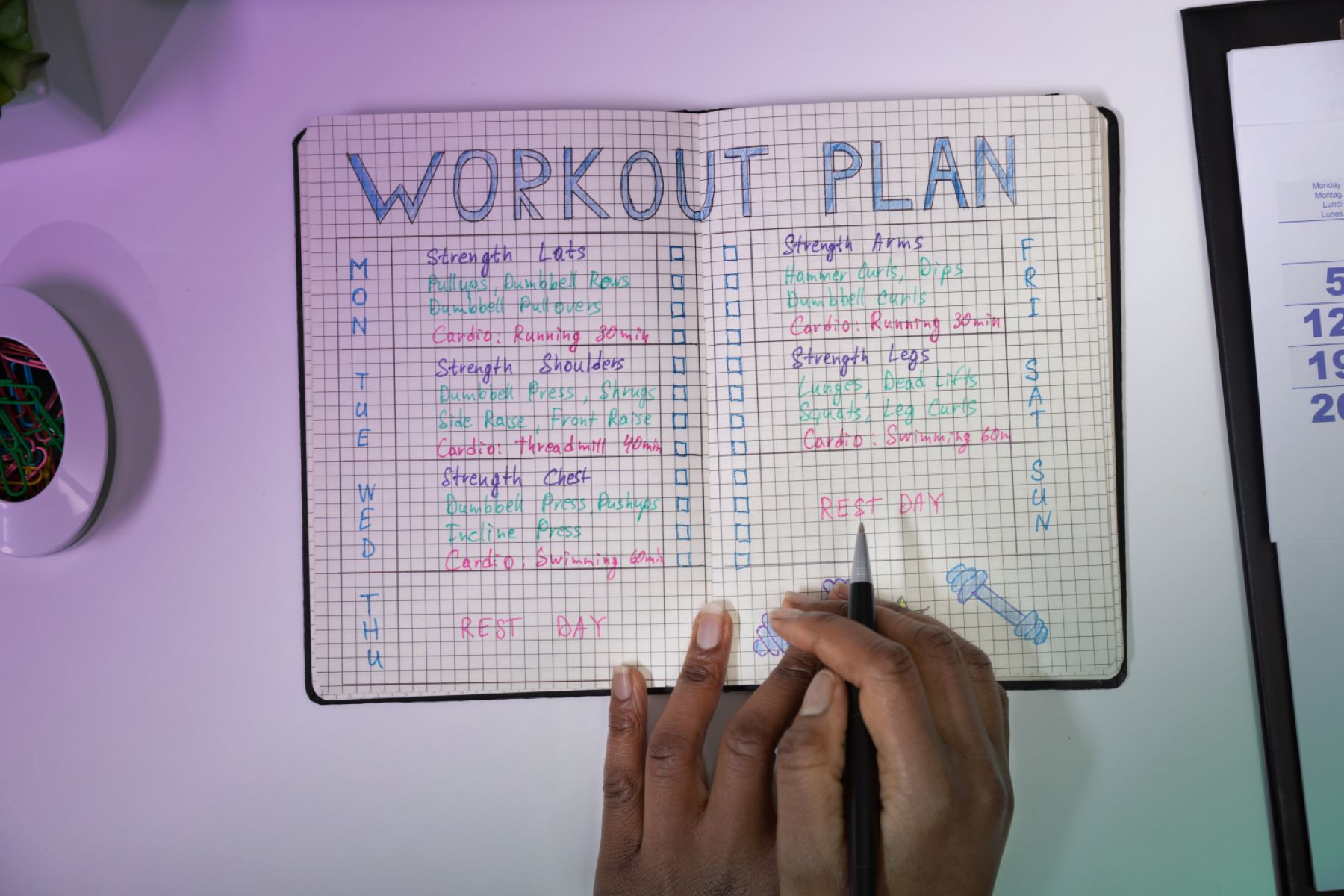Home>Misc>Featured>How Long Should You Exercise To Lose Weight


Featured
How Long Should You Exercise To Lose Weight
Modified: January 2, 2024
Discover the ideal exercise duration for weight loss in this informative article. Follow our expert tips and include the featured workout to optimize your results.
Introduction
When it comes to weight loss, exercise plays a crucial role in achieving your desired goals. But how long should you exercise to effectively lose weight? The answer to this question depends on various factors, including individual circumstances, goals, and overall health. In this article, we will delve into the relationship between exercise and weight loss, explore the factors that can impact weight loss, and provide recommendations for the optimal exercise duration.
Exercise not only helps in burning calories but also improves overall health and well-being. However, it is essential to understand that weight loss is a complex process influenced by various factors, such as genetics, metabolism, diet, and lifestyle. While exercise is an integral part of any weight loss journey, it is not the sole determinant of success.
It’s worth noting that weight loss is not solely about shedding pounds—it’s about achieving a healthy body composition and improving overall fitness. Engaging in regular exercise can help you build lean muscle mass, increase metabolism, and enhance cardiovascular health.
Now, let’s explore the factors that play a crucial role in determining the duration of exercise required for weight loss.
Understanding the Relationship Between Exercise and Weight Loss
Exercise and weight loss are closely interconnected. When we engage in physical activity, our body burns calories, which in turn can contribute to weight loss. Exercise helps create a calorie deficit, which means that you are burning more calories than you consume. This deficit forces your body to tap into stored fat for energy, leading to weight loss over time.
However, the relationship between exercise and weight loss is not as simple as it may seem. Multiple factors come into play, including the intensity and duration of your workouts, the type of exercise you engage in, and your individual metabolism.
High-intensity workouts, such as HIIT (high-intensity interval training) or strength training, can boost your metabolic rate and continue to burn calories even after the workout is completed. While these types of exercises may be more time-efficient, they may not be suitable for everyone, especially those who are just starting their fitness journey or have certain health conditions.
On the other hand, low to moderate-intensity exercises, such as brisk walking, cycling, or swimming, can also contribute to weight loss when performed consistently. These types of exercises are generally more sustainable and can be incorporated into daily routines without putting too much strain on the body.
It’s important to note that exercise alone may not be sufficient for significant weight loss. Diet also plays a crucial role in achieving and maintaining a healthy weight. A well-balanced diet that includes nutrient-dense foods in appropriate portions will complement your exercise routine and enhance weight loss results.
In addition to weight loss, exercise offers numerous other benefits for overall health and well-being. It can help improve cardiovascular health, strengthen muscles and bones, boost mood and mental well-being, and reduce the risk of chronic diseases such as diabetes and certain types of cancer.
As we continue to explore the relationship between exercise and weight loss, it’s essential to understand that there is no “one-size-fits-all” approach. Each individual’s needs and abilities vary, and it’s crucial to listen to your body, set realistic goals, and consult with a healthcare professional or certified fitness expert to design an exercise plan that is safe and effective for you.
Factors Affecting Weight Loss
When it comes to weight loss, several factors can influence the rate and success of your progress. Understanding these factors can help you tailor your exercise routine and make more informed choices to achieve your weight loss goals. Here are some key factors that can affect weight loss:
- Caloric Deficit: Creating a caloric deficit is crucial for weight loss. This means consuming fewer calories than you burn through physical activity and normal bodily functions. It’s important to strike a balance between reducing caloric intake through diet and increasing energy expenditure through exercise to create an appropriate deficit.
- Metabolic Rate: Each person’s metabolic rate, which is the rate at which their body burns calories, is unique. Factors such as genetics, age, gender, body composition, and hormonal levels can influence metabolic rate. Individuals with faster metabolisms may burn calories more quickly, while those with slower metabolisms may need to work harder to create a caloric deficit.
- Body Composition: Body composition refers to the proportion of lean muscle mass, fat mass, and other tissues in the body. Muscle tissue has a higher metabolic rate than fat tissue, meaning that individuals with a higher proportion of muscle tend to burn more calories at rest. Including strength training exercises in your routine can help build and maintain lean muscle mass, contributing to weight loss.
- Individual Differences: Everyone’s body is unique, and individual differences can affect weight loss outcomes. Some individuals may experience rapid weight loss initially, while others may have a slower progress. Hormonal imbalances, medical conditions, medications, and stress levels can also impact weight loss. It’s important to be patient and focus on progress rather than comparing yourself to others.
- Consistency and Compliance: Consistency and compliance are key factors in achieving successful weight loss. Adhering to your exercise routine and maintaining a healthy diet over time is crucial for sustainable weight loss. Small, consistent efforts made over a long period tend to yield better results than sporadic, intense bursts of exercise.
It’s important to note that while exercise plays a significant role in weight loss, it is not the only factor. Other lifestyle factors, such as sleep, stress management, and overall physical activity levels, also contribute to overall health and weight management.
Understanding these factors can help you set realistic expectations and make informed choices to optimize your weight loss journey. Remember, the key is to focus on making sustainable lifestyle changes that promote overall health rather than quick fixes or fad diets.
Recommended Exercise Duration for Weight Loss
When it comes to determining the optimal exercise duration for weight loss, there is no one-size-fits-all answer. The recommended duration can vary based on factors such as fitness level, overall health, and weight loss goals. However, general guidelines can serve as a starting point to help you design an effective exercise routine. Here are some recommended exercise durations for weight loss:
- 150 minutes of moderate-intensity aerobic activity per week: The American Heart Association recommends at least 150 minutes of moderate-intensity aerobic activity, such as brisk walking, cycling, or swimming, spread throughout the week. This translates to about 30 minutes a day, five days a week. This level of activity promotes cardiovascular health and can contribute to weight loss when combined with a balanced diet.
- 75 minutes of vigorous-intensity aerobic activity per week: For those who prefer more intense workouts, engaging in 75 minutes of vigorous-intensity aerobic activity, such as running, HIIT workouts, or kickboxing, per week can also be effective for weight loss. This can be spread out over three to four sessions, lasting around 20-25 minutes each.
- Strength training sessions twice a week: Incorporating strength training exercises into your routine is essential for weight loss. Building lean muscle mass not only burns calories during the workout but also increases metabolism, leading to ongoing calorie burn. Aim for two to three strength training sessions per week, focusing on all major muscle groups.
- Higher durations for greater weight loss goals: If your weight loss goals are more significant, you may need to increase your exercise duration. Gradually increasing your workout time can help you challenge yourself and continue making progress. However, it’s important to do so gradually and listen to your body to avoid overexertion or injury. Consulting with a fitness professional can help you plan an appropriate exercise program based on your weight loss goals and individual needs.
Remember that the key is to find an exercise routine that you enjoy and can sustain long-term. Consistency is key for weight loss, so choose activities that you find enjoyable and can fit into your lifestyle. It’s important to start at a level that is appropriate for your fitness level and gradually increase intensity and duration as you progress.
Lastly, listen to your body and give yourself adequate rest and recovery. Pushing yourself too hard without proper rest can lead to burnout or increased risk of injury. Strive for a balanced approach that combines cardiovascular exercises, strength training, and flexibility activities to promote overall fitness and weight loss.
Different Types of Exercises for Weight Loss
When it comes to weight loss, incorporating a variety of exercises into your routine can help you stay motivated, prevent boredom, and target different muscle groups. Here are some different types of exercises that can aid in weight loss:
- Aerobic exercises: Also known as cardiovascular exercises, aerobic exercises are great for burning calories and improving cardiovascular health. Activities like brisk walking, jogging, running, cycling, swimming, and dancing can elevate your heart rate and help you burn fat. Aim for at least 30 minutes of moderate-intensity aerobic activity on most days of the week.
- High-intensity interval training (HIIT): HIIT workouts involve short bursts of intense exercises followed by brief recovery periods. This type of training can be an efficient way to burn calories, boost metabolism, and improve cardiovascular fitness. HIIT workouts can be done with various exercises like burpees, jumping jacks, mountain climbers, and squat jumps.
- Strength training: Incorporating strength training exercises into your routine is vital for weight loss. Building lean muscle mass not only increases metabolism but also helps shape and tone your body. Use resistance bands, dumbbells, or your body weight to perform exercises like squats, lunges, push-ups, and deadlifts. Aim for two to three strength training sessions per week, targeting all major muscle groups.
- Pilates: Pilates is a low-impact exercise that focuses on core strength, flexibility, and body awareness. It involves a series of precise, controlled movements that engage multiple muscle groups. Pilates can help improve posture, build strength, and enhance overall body tone. Incorporate Pilates exercises into your routine to improve stability and core strength.
- Yoga: Yoga is a holistic exercise that combines physical postures, breathing exercises, and meditation. It not only helps improve flexibility, strength, and balance but also reduces stress and promotes mental well-being. Different forms of yoga, such as Hatha, Vinyasa, or Power Yoga, offer a variety of intensities to suit different fitness levels.
- Outdoor activities: Engaging in outdoor activities, such as hiking, swimming, or playing sports, can make exercise more enjoyable and help you burn extra calories. Not only do you get the benefits of physical activity, but you also get to enjoy nature and fresh air.
Remember that the best exercise for weight loss is the one that you enjoy and can stick to consistently. It’s essential to find activities that fit your interests, preferences, and fitness level. You can mix and match different types of exercises to create a well-rounded routine that keeps you motivated and engaged.
Additionally, consulting with a fitness professional or certified personal trainer can help you design a personalized exercise program tailored to your weight loss goals and individual needs. They can help ensure proper form, provide guidance, and adapt the program as you progress.
Designing an Effective Exercise Routine for Weight Loss
Creating an effective exercise routine is crucial for achieving your weight loss goals. A well-designed routine ensures that you are engaging in the right types and amounts of exercises to maximize calorie burn, build muscle, and promote overall fitness. Here are some tips for designing an effective exercise routine for weight loss:
- Set clear goals: Start by setting clear and realistic weight loss goals. Determine how much weight you want to lose and the timeframe in which you aim to achieve it. Having specific goals will help guide your exercise routine and keep you motivated.
- Include a variety of exercises: Incorporate a mix of aerobic exercises, strength training, and flexibility exercises into your routine to target different muscle groups and promote overall fitness. This variety will also help prevent boredom and plateaus in your progress.
- Gradually increase intensity: Start at a level that is suitable for your fitness level and gradually increase the intensity and duration of your workouts over time. This gradual progression allows your body to adapt and helps prevent injury. Listening to your body and adjusting the intensity as needed is essential for long-term success.
- Find activities you enjoy: Choose exercises and activities that you enjoy. If you’re not a fan of running, try swimming or cycling instead. Enjoying the activities you do will make it easier to stick to your routine. Consider joining group classes, participating in team sports, or working out with a friend to add a social aspect to your exercise routine.
- Plan your workouts: Schedule dedicated workout sessions in your calendar. Treat these sessions as non-negotiable commitments to yourself. Planning your workouts ahead of time helps ensure that you prioritize exercise and make it a consistent part of your routine.
- Include rest days: Rest days are just as important as your workout days. They give your body time to recover and rebuild, reducing the risk of overtraining and injury. Aim for one to two rest days per week. On these days, engage in light activities like stretching, walking, or yoga.
- Monitor and track progress: Keep track of your workouts, including the exercises you perform, the duration, and any changes in intensity or weight lifted. This tracking allows you to see your progress over time and make adjustments to your routine as needed.
Remember, consistency is key. It’s better to have short but regular workouts than sporadic, intense workouts. Aim for at least 150 minutes of moderate-intensity aerobic activity spread throughout the week and two to three strength training sessions.
Don’t hesitate to seek guidance from a fitness professional or personal trainer who can help assess your fitness level, design a personalized plan, and provide support throughout your weight loss journey.
Combining Exercise with a Healthy Diet for Optimal Weight Loss
When it comes to weight loss, exercise and diet go hand in hand. While exercise helps burn calories and improve overall fitness, combining it with a healthy diet is essential for optimal weight loss results. Here’s why combining exercise with a healthy diet is crucial:
- Creating a calorie deficit: Weight loss occurs when you consume fewer calories than you burn. Exercise helps increase calorie burn, while a healthy diet ensures that you are consuming nutrient-dense foods in appropriate portions. The combination of exercise and a balanced diet helps achieve and sustain a calorie deficit, leading to weight loss over time.
- Supporting muscle growth and recovery: Exercise, especially strength training, helps build and maintain lean muscle mass. A healthy diet provides the necessary nutrients, such as protein, to support muscle growth and aid in recovery. This combination helps preserve muscle mass while burning fat, resulting in a leaner and more toned body.
- Boosting metabolism: Regular exercise, particularly high-intensity workouts, can boost metabolism and increase the number of calories burned at rest. When combined with a healthy diet that includes metabolism-boosting foods, such as lean proteins, fruits, vegetables, and whole grains, you can further enhance your metabolic rate and support weight loss efforts.
- Improving energy levels and performance: A well-balanced diet provides the necessary nutrients and fuel to support physical activity. Proper nutrition helps improve energy levels, fuel workouts, and enhance exercise performance. Consuming a combination of carbohydrates, proteins, and healthy fats before and after workouts can optimize energy levels and aid in muscle recovery.
- Promoting overall health: A healthy diet combined with exercise is not only beneficial for weight loss but also for overall health and well-being. A balanced diet rich in fruits, vegetables, whole grains, and lean proteins provides essential vitamins, minerals, and antioxidants. Regular exercise helps improve cardiovascular health, reduce the risk of chronic diseases, boost mood, and enhance mental well-being.
To combine exercise with a healthy diet for optimal weight loss, consider the following tips:
- Focus on whole foods: Choose nutrient-dense, whole foods such as fruits, vegetables, lean proteins, whole grains, and healthy fats. Avoid processed foods, sugary snacks, and drinks that provide empty calories.
- Portion control: Pay attention to portion sizes to ensure you are not consuming excess calories. Use smaller plates, measure serving sizes, and listen to your body’s hunger and fullness cues.
- Stay hydrated: Drink plenty of water throughout the day to support proper digestion, metabolism, and overall health. Hydration is crucial for optimal exercise performance as well.
- Fuel properly before and after workouts: Consume a combination of carbohydrates and protein before and after exercising to provide energy, support muscle growth, and aid in recovery. Opt for whole foods such as bananas, Greek yogurt, or a small chicken breast with brown rice.
- Seek professional guidance: Consider consulting with a registered dietitian or nutritionist who can assess your nutritional needs, help create a personalized meal plan, and provide ongoing support and guidance.
Remember, weight loss is a gradual process, and sustainable results come from long-term lifestyle changes. By combining exercise with a healthy diet, you create a powerful synergy that supports your weight loss journey while promoting overall health and well-being.
Importance of Consistency in Exercise for Weight Loss
Consistency is a key factor in achieving successful weight loss through exercise. While occasional workouts may provide temporary benefits, it is the regular and consistent effort that yields lasting results. Here are the reasons why consistency is crucial for weight loss:
- Building a habit: Consistency helps you build a habit of exercise. When you make exercise a regular part of your routine, it becomes easier to stick to and becomes ingrained in your lifestyle. By consistently showing up for your workouts, you train your mind and body to prioritize and enjoy physical activity.
- Maintaining a calorie deficit: Sustainable weight loss occurs when you consistently maintain a calorie deficit. Irregular exercise patterns can disrupt the balance between calorie intake and expenditure. By consistently engaging in regular exercise, you can ensure that you are consistently burning calories and creating a sustained calorie deficit, leading to weight loss over time.
- Burning stored fat: Regular exercise helps your body access stored fat for energy. By being consistent, you allow your body to tap into those fat stores on a regular basis, encouraging weight loss. Inconsistent workout patterns may cause your body to rely more on glycogen or muscle for energy, reducing the effectiveness of fat burning.
- Improved fitness and performance: Consistent exercise allows your body to adapt and improve over time. Regular workouts help improve cardiovascular health, build strength and endurance, and enhance overall fitness. By staying consistent, you can gradually increase intensity, duration, and resistance, challenging your body and continuously progressing toward your weight loss goals.
- Psychological benefits: Consistency in exercise has psychological benefits as well. Regular physical activity can boost mood, reduce stress, and improve mental well-being. Exercise releases endorphins, which are known as “feel-good” hormones, promoting a positive mindset and motivation to continue your weight loss journey.
When it comes to consistency, it’s important to find a balance that works for you. Overcommitting and trying to do too much too soon can lead to burnout or injury. Start with a realistic exercise schedule, gradually increase intensity and duration, and listen to your body’s cues. Remember, consistency is about finding a sustainable rhythm that you can maintain in the long run.
It can be helpful to establish a routine and set specific workout times. Treat your exercise sessions as non-negotiable appointments with yourself. Incorporate activities you enjoy, vary your workouts, and seek support and accountability from friends, family, or a fitness community.
Lastly, be kind to yourself. Embrace the occasional setbacks or missed workouts without viewing them as failures. Understand that consistency is a journey, and progress takes time. Stay focused on your goals, stay consistent, and celebrate every step forward towards a healthier and fitter you.
Monitoring Progress and Adjusting Exercise Duration
Monitoring your progress and making necessary adjustments to your exercise duration is a crucial aspect of achieving successful weight loss. By regularly assessing your progress, you can determine if your current exercise routine is effective or if it requires modifications. Here’s why monitoring progress and adjusting exercise duration is important:
- Evaluating effectiveness: Monitoring your progress helps you evaluate the effectiveness of your current exercise routine. By tracking metrics such as weight, body measurements, and fitness benchmarks, you can determine whether your efforts are leading to the desired outcomes. If you aren’t progressing as expected, it may be time to adjust your exercise duration.
- Preventing plateaus: Plateaus can occur when your body adapts to your current exercise routine and weight loss slows down or stalls. Regularly monitoring your progress allows you to identify when a plateau occurs, signaling the need for adjustments. By adjusting your exercise duration, intensity, or incorporating new exercises, you can challenge your body and continue making progress.
- Listening to your body: Paying attention to your body’s signals is essential for avoiding overtraining and injury. If you notice persistent fatigue, performance decline, or chronic soreness, it may be a sign that your current exercise duration is too intense or too long. Adjusting your workout duration allows you to find a balance that challenges you without pushing your body beyond its limits.
- Progressing towards goals: Monitoring progress helps you stay on track and make incremental adjustments towards your weight loss goals. By reviewing your progress regularly, you can celebrate small victories and adjust your exercise duration accordingly to keep moving closer to your ultimate goal.
- Keeping motivation high: Seeing progress and making adjustments to your exercise routine can boost motivation. When you track your progress, you can celebrate achievements and use them as fuel to stay consistent and committed. On the other hand, if you notice little progress, it can serve as a wake-up call to make necessary changes and reignite your motivation.
When monitoring progress and adjusting exercise duration, consider the following steps:
- Regularly assess your progress: Set consistent intervals for evaluating your progress, whether it’s weekly, biweekly, or monthly. Use tools such as weight scales, body measurements, progress photos, or fitness tests to track changes and improvements.
- Consult professionals: Seek guidance from fitness professionals, personal trainers, or healthcare providers who can provide expertise on evaluating progress and making appropriate adjustments to your exercise duration.
- Gradually adjust exercise duration: When making adjustments, do so gradually. Introduce small changes to exercise duration, intensity, or frequency to avoid overwhelming your body and minimize the risk of injury. Incremental adjustments allow for a smooth transition and help your body adapt to new challenges.
- Listen to your body: Pay attention to your body’s signals and adjust your exercise duration based on how you feel. If you’re experiencing excessive fatigue or pain, it may be a sign to decrease intensity or take a rest day. Conversely, if you find your workouts becoming too easy, it might be time to increase exercise duration or intensity.
- Stay flexible and open to change: Be prepared to adapt and change your exercise routine as needed. Progression is not always linear, and different stages of your weight loss journey may require different strategies. Embrace flexibility and embrace adjustments that align with your goals and individual needs.
Remember, monitoring progress and adjusting exercise duration is an ongoing process. Regularly assess your progress, listen to your body, and make the necessary tweaks to optimize your workouts and keep progressing towards your weight loss goals.
Conclusion
In conclusion,
The relationship between exercise and weight loss is complex, and there is no one-size-fits-all approach. However, by understanding the relationship between exercise and weight loss, considering factors affecting weight loss, following recommended exercise durations, incorporating various types of exercises, designing an effective exercise routine, combining exercise with a healthy diet, maintaining consistency, monitoring progress, and adjusting exercise duration, you can make significant strides towards achieving your weight loss goals.
Remember, successful weight loss is a journey that requires patience, dedication, and a holistic approach. It’s important to focus on long-term lifestyle changes, rather than quick fixes or fad diets. Incorporating regular exercise into your routine not only helps with weight loss but also supports overall health, improves fitness, and enhances mental well-being.
Stay committed to your goals, find enjoyment in your workouts, and make self-care a priority. Seek support from professionals or a community to stay motivated and accountable. Embrace the process, celebrate your progress, and be kind to yourself along the way. With consistency, determination, and a balanced approach, you can achieve sustainable weight loss and embark on a healthier, happier lifestyle.









